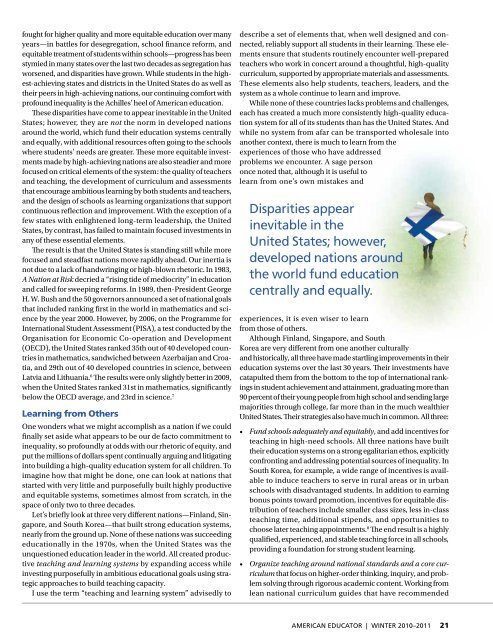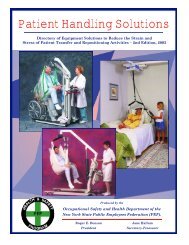American Educator, Winter 2010-11, Vol. 34, No. 4, AFT
American Educator, Winter 2010-11, Vol. 34, No. 4, AFT
American Educator, Winter 2010-11, Vol. 34, No. 4, AFT
Create successful ePaper yourself
Turn your PDF publications into a flip-book with our unique Google optimized e-Paper software.
fought for higher quality and more equitable education over many<br />
years—in battles for desegregation, school finance reform, and<br />
equitable treatment of students within schools—progress has been<br />
stymied in many states over the last two decades as segregation has<br />
worsened, and disparities have grown. While students in the highest-achieving<br />
states and districts in the United States do as well as<br />
their peers in high-achieving nations, our continuing comfort with<br />
profound inequality is the Achilles’ heel of <strong>American</strong> education.<br />
These disparities have come to appear inevitable in the United<br />
States; however, they are not the norm in developed nations<br />
around the world, which fund their education systems centrally<br />
and equally, with additional resources often going to the schools<br />
where students’ needs are greater. These more equitable investments<br />
made by high-achieving nations are also steadier and more<br />
focused on critical elements of the system: the quality of teachers<br />
and teaching, the development of curriculum and assessments<br />
that encourage ambitious learning by both students and teachers,<br />
and the design of schools as learning organizations that support<br />
continuous reflection and improvement. With the exception of a<br />
few states with enlightened long-term leadership, the United<br />
States, by contrast, has failed to maintain focused investments in<br />
any of these essential elements.<br />
The result is that the United States is standing still while more<br />
focused and steadfast nations move rapidly ahead. Our inertia is<br />
not due to a lack of handwringing or high-blown rhetoric. In 1983,<br />
A Nation at Risk decried a “rising tide of mediocrity” in education<br />
and called for sweeping reforms. In 1989, then-President George<br />
H. W. Bush and the 50 governors announced a set of national goals<br />
that included ranking first in the world in mathematics and science<br />
by the year 2000. However, by 2006, on the Programme for<br />
International Student Assessment (PISA), a test conducted by the<br />
Organisation for Economic Co-operation and Development<br />
(OECD), the United States ranked 35th out of 40 developed countries<br />
in mathematics, sandwiched between Azerbaijan and Croatia,<br />
and 29th out of 40 developed countries in science, between<br />
Latvia and Lithuania. 6 The results were only slightly better in 2009,<br />
when the United States ranked 31st in mathematics, significantly<br />
below the OECD average, and 23rd in science. 7<br />
Learning from Others<br />
One wonders what we might accomplish as a nation if we could<br />
finally set aside what appears to be our de facto commitment to<br />
inequality, so profoundly at odds with our rhetoric of equity, and<br />
put the millions of dollars spent continually arguing and litigating<br />
into building a high-quality education system for all children. To<br />
imagine how that might be done, one can look at nations that<br />
started with very little and purposefully built highly productive<br />
and equitable systems, sometimes almost from scratch, in the<br />
space of only two to three decades.<br />
Let’s briefly look at three very different nations—Finland, Singapore,<br />
and South Korea—that built strong education systems,<br />
nearly from the ground up. <strong>No</strong>ne of these nations was succeeding<br />
educationally in the 1970s, when the United States was the<br />
unquestioned education leader in the world. All created productive<br />
teaching and learning systems by expanding access while<br />
investing purposefully in ambitious educational goals using strategic<br />
approaches to build teaching capacity.<br />
I use the term “teaching and learning system” advisedly to<br />
describe a set of elements that, when well designed and connected,<br />
reliably support all students in their learning. These elements<br />
ensure that students routinely encounter well-prepared<br />
teachers who work in concert around a thoughtful, high-quality<br />
curriculum, supported by appropriate materials and assessments.<br />
These elements also help students, teachers, leaders, and the<br />
system as a whole continue to learn and improve.<br />
While none of these countries lacks problems and challenges,<br />
each has created a much more consistently high-quality education<br />
system for all of its students than has the United States. And<br />
while no system from afar can be transported wholesale into<br />
another context, there is much to learn from the<br />
experiences of those who have addressed<br />
problems we encounter. A sage person<br />
once noted that, although it is useful to<br />
learn from one’s own mistakes and<br />
Disparities appear<br />
inevitable in the<br />
United States; however,<br />
developed nations around<br />
the world fund education<br />
centrally and equally.<br />
experiences, it is even wiser to learn<br />
from those of others.<br />
Although Finland, Singapore, and South<br />
Korea are very different from one another culturally<br />
and historically, all three have made startling improvements in their<br />
education systems over the last 30 years. Their investments have<br />
catapulted them from the bottom to the top of international rankings<br />
in student achievement and attainment, graduating more than<br />
90 percent of their young people from high school and sending large<br />
majorities through college, far more than in the much wealthier<br />
United States. Their strategies also have much in common. All three:<br />
• Fund schools adequately and equitably, and add incentives for<br />
teaching in high-need schools. All three nations have built<br />
their education systems on a strong egalitarian ethos, explicitly<br />
confronting and addressing potential sources of inequality. In<br />
South Korea, for example, a wide range of incentives is available<br />
to induce teachers to serve in rural areas or in urban<br />
schools with disadvantaged students. In addition to earning<br />
bonus points toward promotion, incentives for equitable distribution<br />
of teachers include smaller class sizes, less in-class<br />
teaching time, additional stipends, and opportunities to<br />
choose later teaching appointments. 8 The end result is a highly<br />
qualified, experienced, and stable teaching force in all schools,<br />
providing a foundation for strong student learning.<br />
• Organize teaching around national standards and a core curriculum<br />
that focus on higher-order thinking, inquiry, and problem<br />
solving through rigorous academic content. Working from<br />
lean national curriculum guides that have recommended<br />
AMERICAN EDUCATOR | WINTER <strong>2010</strong>–20<strong>11</strong> 21





